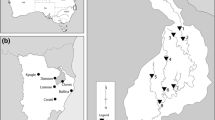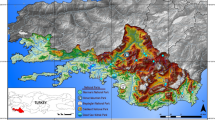Abstract
Benthic diatoms are important indicators of ecological conditions in lotic systems. The objective of this study was to elucidate the confounding effects of eutrophication, organic pollution and ionic strength and conductivity on benthic diatom communities. Benthic diatoms and water quality sampling was done at 10 sites during summer base flow period (2008 and 2009). Detrended correspondence analysis (DCA) and canonical correspondence analysis (CCA) were used to determine environmental gradients along which species vary with respect to ionic strength and conductivity and other environmental variables. Using variance partitioning, we assessed the individual importance of a set of environmental variables (eutrophication and organic pollution) versus ionic strength and conductivity on diatom community structure. The effects of ionic strength and conductivity and organic pollution, eutrophication and other environmental variables were integrated into overall resultant benthic diatom communities. Through partial CCA, we partitioned the variance in diatom data between two sets of exploratory variables, i.e. ionic strength and conductivity (26.9%); other variables, particularly eutrophication and organic pollution (23.0%); shared variance (11.3%) and unexplained variance (38.8%). Due to the interaction of the effects of ionic strength and conductivity and other variables in this study, laboratory experiments must be performed to confirm the observed effects of ionic strength and conductivity.



Similar content being viewed by others
References
APHA & M. A. H. Franson (eds), 1988. Standard Methods for the Examination of Water and Waste Water, 20th ed. American Public Health Association, Washington, DC.
Bere, T. & J. G. Tundisi, 2009. Weighted average regression and calibration of conductivity and pH of benthic diatoms in streams influenced by urban pollution – Sao Carlos/SP Brazil. Acta Limnol Brasilliansea 21: 317–325.
Bicudo, C. E. M. & M. Menezes, 2006. Gêneros de água de águas continentais do Brazil: chave para identificação e descrições. Rima Editora, São Carlos-SP Brazil: 391–339.
Biggs, B. J. F. & C. Kilroy, 2000. Stream priphyton monitoring manual. NIWA, Christchurch, New Zealand.
Boisson, J. C. & Y. Perrodia, 2006. Effects of runoff on biomass and metabolic activity of periphyton in experimental streams. Journal of Hazardus Material A132: 148–154.
Borcard, D., P. Legendre & P. Drapeau, 1992. Partialling out the spatial component of ecological variation. Ecology 73: 1045–1055.
Boston, H. L., W. R. Hill & A. J. Stewart, 1991. Evaluating direct toxicity and food chain effects in aquatic systems using natural periphyton communities. In: J. W. Gorsuch, W. R. Lower, & K. R. St. John (eds.), Plants for Toxicity Assessment, Vol. 2. ASTM STP 1115, Philadelphia, PA: 126–145.
Carpenter, K. D. & I. R. Waite, 2000. Relations of habitat-specific algal assemblages to land-use and water chemistry in the Willamette Basin, Oregon. Environmetal Monitoring and Assesment 64: 247–257.
Cohn, S. A. & N. C. Disparti, 1994. Environmental factors influencing diatom cell motility. Journal of Phycology 30: 818–828.
Defew, E. C., D. M. Paterson & S. E. Hagerthey, 2002. The use of natural microphytobenthic assemblages as laboratory model systems. Marine Ecology Progress Series 237: 15–25.
Dickson, K. L., J. R. Cairns, B. C. Gregg, D. I. Messenger, J. L. Plafkin & W. H. van der Schalie, 1977. Effects of intermittent chlorination on aquatic organisms and communities. Journal of Water Pollution Control 49: 35–44.
Dionex Corporation, 2001. Dionex DX-80 Ion Analyzer Operator’s Manual. USA.
Dionisio-Sese, M. L. & S. Miyachi, 1992. The effect of sodium chloride on carbonic anhydrase activity in marine microalgae. Journal of Phycology 28: 619–624.
Fritz, S. C., S. Juggins, R. W. Battarbee & D. R. Engstrom, 1991. Reconstruction of past changes in salinity and climate using a diatom-based transfer function. Nature 352: 706–708.
Fritz, S. C., S. Juggins & R. W. Battarbee, 1993. Diatom assemblages and ionic characterization of lakes of the Northern Great Plains, North America: a tool for reconstructing past salinity and climate fluctuations. Canadian Journa of Fisheries and Aquatic Sciences 50: 1844–1856.
Fukushima, S. & S. Kanada, 1999. Effects of chlorine on periphytic algae and macroinvertebrates in a stream receiving treated sewage as maintenance water. Japanese Journal of Limnology 60: 569–583.
Fukushima, S., Y. Koichi & H. Fukushima, 1994. Effects of self-purification on periphytic algal communities. Verhandlungen Internationale Vereinigung für Theoretische und Angewandte Limnologie 25: 1966–1970.
Gasse, F., S. Juggins & L. B. Khelifa, 1995. Diatom-based transfer functions for inferring past hydrochemical characteristics of African lakes. Palaeogeography and Palaeoecology 117: 31–54.
Gómez, N. & M. Licursi, 2001. The Pampean Diatom Index (IDP) for assessment of rivers and streams in Argentina. Aquatic Ecology 35: 173–181.
Hammer, O., D. A. T. Harper & P. D. Ryan, 2009. PAST – PAlaeontological STatistics, version 1.90. http://folk.uio.no/ohammer/past.
Herbst, D. B. & D. W. Blinn, 1998. Experimental mesocosm studies of salinity effects on the benthic algal community of a saline lake. Journal of Phycology 34: 772–778.
Jüttner, I., H. Rothfritz & S. J. Ormerod, 1996. Diatoms as indicators of river quality in the Nepalese Middle Hills with consideration of the effects of habitat-specific sampling. Freshwater Biology 36: 475–486.
Kelly, M. G. & B. A. Whitton, 1995. The trophic diatom index: a new index for monitoring eutrophication in rivers. Journal of Applied Phycology 7: 433–444.
Kilham, P., S. S. Kilham & R. E. Hecky, 1986. Hypothesized resources relationships among African plankton diatoms. Limnology and Oceanography 31: 1169–1181.
Kobayasi, H. & S. Mayama, 1989. Most pollution-tolerant diatoms of severely polluted rivers in the vicinity of Tokyo. Japanese Journal of Phycology 30: 188–196.
Lange-Bertalot, H., 1979. Pollution tolerance of diatoms as criteria for water quality estimation. Nova Hedwigia 64: 283–304.
Lavoie, I., S. Campeau, F. Darchambeau, G. Cabana & P. J. Dillon, 2008. Are diatoms good integrators of temporary variability in stream water quality? Freshwater Biology 53: 827–841.
Leland, H. V., 1995. Distribution of phytobenthos in the Yakima River basin, Washington, in relation to geology, land use, and other environmental factors. Canadian Journal of Fisheries and Aquatic Sciences 52: 1108–1129.
Lobo, E. A., V. L. Callegaro & P. Bender, 2002. Utilização de algas diatomáceas epilíticas como indicadoras da qualidade da água em rios e arroios da Região Hidrográfica do Guaíba, RS, EDUNISC. Santa Cruz do Sul, Brasil.
Lobo, E. A., V. L. M. Callegaro, G. Hermany, D. Bes, C. A. Wetzel & M. A. Oliveria, 2004. Use of epilithic diatoms as bioindicators from lotic systems in southern Brazil, with special emphasis on eutrophication. Acta Limnologica Brasiliensia 16: 25–40.
Metzeltin, D., H. Lange-Bertalot & F. García-Rodríguez, 2005. Diatoms of Uruguay. Iconographia Diatomologica 15: 1–736.
Metzeltin, D. & H. Lange-Bertalot, 2007. Tropical diatoms of South America II. Iconographia Diatomologica 18: 1–877.
Napolitano, G. E., W. R. Hill, J. B. Guckert, A. J. Stewart, S. C. Nold & D. C. White, 1994. Changes in periphyton fatty acid composition in chlorine polluted streams. Journal of North American Benthological Scociety 13: 237–249.
Oliveira, M. A., L. C. Torgan, E. A. Lobo & A. Scharzbold, 2001. Association of periphytic diatom species of artificial substrate in lotic environments in the Arroio Sampaio basin, RS, Brazil: relationships with abiotic variables. Brazilian Journal of Biolology 6: 523–540.
Pan, Y., R. J. Stevenson, B. H. Hill, A. T. Herlihy & G. B. Collins, 1996. Using diatoms as indicators of ecological conditions in lotic systems: a regional assessment. Journal of North American Bethological Society 15: 481–495.
Patrick, R. & C. W. Reimer, 1966. The Diatoms of the United States. Academy of Natural Sciences, Philadelphia: 688.
Pearsall, W. H., 1932. Phytoplankton in the English Lakes II. Composition of the phytoplankton in relation to dissolved substances. Journal of Ecology 2: 241–262.
Ponader, K. C., D. F. Charles & T. J. Belton, 2007. Diatom-based TP and TN inference models and indices for monitoring nutrient enrichment of New Jersey streams. Ecological Indicators 7: 79–93.
Potapova, M. G. & D. F. Charles, 2002. Benthic diatoms in USA Rivers: distributions along speciation and environmental gradients. Journal of Biogeography 29: 167–187.
Potapova, M. & D. F. Charles, 2003. Distribution of benthic diatoms in U.S. rivers in relation to conductivity and ionic composition. Freshwater Biology 48: 1311–1328.
Rörig, L. R., J. G. Tundisi, C. A. F. Schettini, J. Pereira-Filho, J. T. Menezes, T. C. M. Almeida, S. R. Urban, C. M. Radetski, R. C. Sperb, C. A. Stramosk, R. S. Macedo, M. A. Castro-Silva & J. A. A. Perez, 2007. From a water resource to a point pollution source: the daily journey of a coastal urban stream. Brazilian Journal of Biology 67: 597–609.
Rothfritz, H., I. Juttner, A. M. Suren & S. J. Ormerod, 1997. Epiphytic and epilithic diatom communities along environmental gradients in the Nepalese Himalaya: implications for the assessment of biodiversity and water quality. Archive für Hydrobiologia 138: 465–482.
Rott, E., H. C. Duthie & E. Pipp, 1998. Monitoring organic pollution and eutrophication in the Grand River, Ontario, by means of diatoms. Canadiam Journal of Fisheries and Aquatic Sciences 55: 1443–1453.
Round, F. E., 1991. Diatoms in river water-monitoring studies. Journal of Applied Phycology 3: 129–145.
Salomoni, S. E., O. Rocha, V. L. Callegaro & E. A. Lobo, 2006. Epilithic diatoms as indicators of water quality in the Gravataí river, Rio Grande do Sul, Brazil. Hydrobiologia 559: 233–246.
Saros, J. E. & S. C. Fritz, 2000. Nutrients as a link between ionic concentrations composition and diatom distributions in saline lakes. Journal of Paleolimnology 23: 449–453.
Sládecék, V., 1986. Diatoms as indicators of organic pollution. Acta Hydrochimica et Hydrobiologica 1986(14): 555–566.
Stevenson, R. J., 2006. Refining diatom indicators for valued ecological attributes & development of water quality criteria. In Ognjanova-Rumenova, N. & K. Manoylov (eds.), Advances in Phycological Studies. Pensoft Publishers, Moscow, Russia: 365–383.
Ter Braak, C. J. F. & I. C. Prentice, 1988. A theory of gradient analysis. Advances in Ecological Research 18: 271–317.
Ter Braak, C. J. F. & P. Šmilauer, 2002. CANOCO Reference Manual and CanDraw for Windows User’s Guide: software for community ordination, version 4.5. Microcomputer Power, Ithaca, New York.
Ter Braak, C. J. F. & P. F. M. Verdonschot, 1995. Canonical correspondence analysis and related multivariate methods in aquatic ecology. Aquatic Sciences 37: 130–137.
Van Dam, H., A. Mertens & J. Sinkeldam, 1994. A coded checklist and ecological indicator values of freshwater diatoms from the Netherlands. Aquatic Ecology 28: 117–133.
Videau, C., M. Khalanski & M. Penot, 1980. Physiological response to chlorination marine alga Dunaliella primolecta Butcher. Journal of Experimental and Marine Biology 47: 113–126.
Winter, J. G. & H. C. Duthei, 2000. Epilithic diatoms as indicators of stream total N and total P concentrations. Journal of North American Benthological Society 19: 32–49.
Acknowledgments
This study was made possible by the provision of funds from Third World Academy of Science through Conselho Nacional de Desenvolvimento Científico e Tecnológico. I also wish to thank the Insttituto Internacional de Ecologia management and staff for their support during the course of this study.
Author information
Authors and Affiliations
Corresponding author
Additional information
Handling editor: N.R. Bond
Rights and permissions
About this article
Cite this article
Bere, T., Tundisi, J.G. Influence of ionic strength and conductivity on benthic diatom communities in a tropical river (Monjolinho), São Carlos-SP, Brazil. Hydrobiologia 661, 261–276 (2011). https://doi.org/10.1007/s10750-010-0532-0
Received:
Revised:
Accepted:
Published:
Issue Date:
DOI: https://doi.org/10.1007/s10750-010-0532-0




